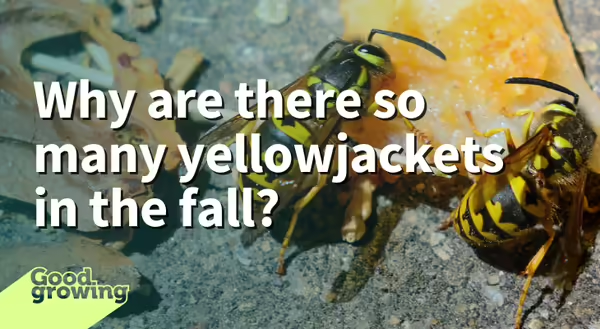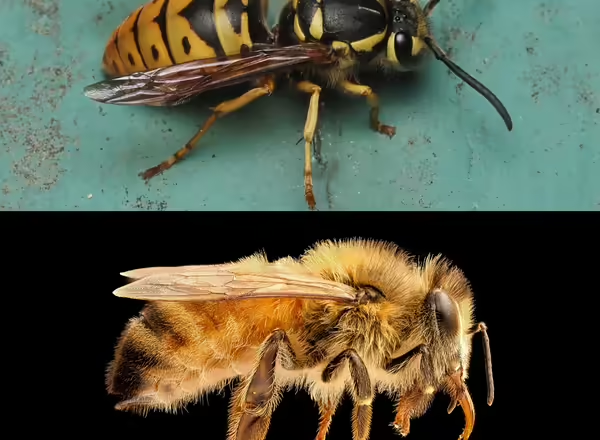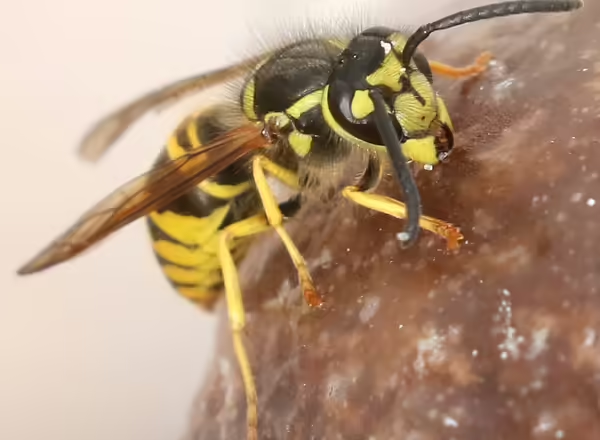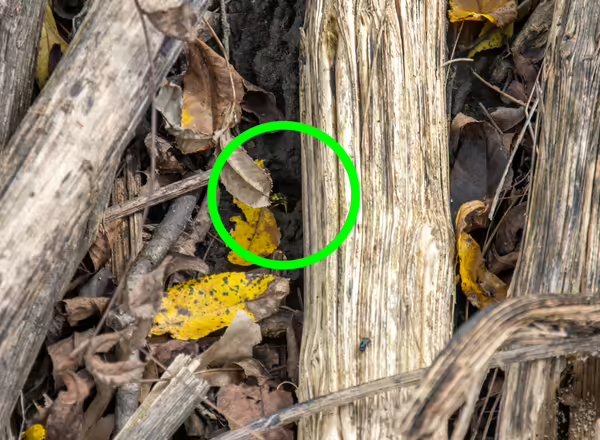
Despite the bad name they get, yellowjackets (Vespula spp.) are beneficial insects. The larvae are meat eaters, consuming caterpillars and other insects (and occasionally carrion) that adults have captured and brought back to the nest. Adults, on the other hand, primarily feed on flower nectar and other sweet liquids and may pollinate flowers as they visit them. However, as the calendar creeps closer and closer to fall, we often encounter yellowjackets more frequently, which can result in painful stings.
Is it a yellowjacket or a bee?
Yellowjackets are commonly confused with honey bees and are often referred to as ground bees (they are wasps). Honey bees and yellowjackets are similar in size (both are about ½ long) and coloration. Despite this, they are rather easy to tell apart (if you’re willing to look close enough). Yellowjackets have bright yellow and black bands on their abdomens and are shiny, while honey bees are golden brown and fuzzy. Yellow jackets are also capable of stinging multiple times.
Why do we see more yellowjackets in the fall?
To understand why we often start seeing yellowjackets more frequently in the fall, we need to look at their lifecycle. Yellowjacket queens will overwinter in protected areas (under the bark of rotting trees, leaf litter, firewood, etc.), and come spring, they will emerge and begin constructing nests. Nests are usually built underground but may occasionally be built in building walls. Colonies are annual, meaning a new one is started every year; they do not reuse nests.
As the seasons progress, several generations of wasps will be produced. By late summer, nests may contain thousands of workers. This is when they can begin to cause problems. All of these wasps need something to eat. As fall approaches and progresses, there are often fewer plants blooming in our landscapes, reducing the amount of food available for yellowjacket colonies. This means we can end up with large populations of hungry wasps with little food to eat. Because of this lack of food, they will begin searching far and wide for it.
Yellowjackets will also aggressively protect their nests, and people often come into conflict with them while mowing or during other outdoor activities near their nests. As the population of wasps in a nest gets higher, there will potentially be more wasps defending the nests.
Keeping yellowjackets away
Yellowjackets are attracted to sweet food items such as carbonated beverages, juices, candy, fruit, and ice cream, which is why we often encounter them during outdoor events. To make these events less attractive to yellowjackets, keep food and drinks covered until it is time to eat them, quickly clean up spills, and promptly put leftovers away.
If yellow jackets are abundant, be careful when drinking from cans; yellowjackets may crawl into cans unnoticed. Pouring beverages into cups outdoors so you can see what you are drinking or placing your thumb over can openings can help avoid this.
Trash cans should be covered with a tight-fitting lid. It’s also helpful to keep trash cans away from areas where food is being served and high-traffic areas.
If a yellowjacket decides to check you out, blow on it or brush it away rather than swatting at it, which may result in you getting stung.



Managing yellowjackets
If the nest is located away from high-traffic areas, a good option is to wait and do nothing since nests will die out once cold temperatures arrive. However, occasionally, nests are in areas and pose a threat to people.
It is best to treat nests at dawn or dusk when they are least active and when wasps have returned to the nest. Wasps will fly at light, so if you use a flashlight, cover it in red cellophane (they cannot see red). Also, wear protective clothing (long pants, long sleeves, gloves, etc.). If accessing the nest is difficult or you are uncomfortable treating yourself, contact a professional pest control company.
In-ground yellowjacket colonies can be managed by applying an insecticide into the nest. After the nest has been drenched or dusted, place a shovel full of soil over the exit hole. If the nest is inside a building, use an approved insecticidal dust on wall openings where the yellowjackets enter. Do not seal the entrance to a colony in a wall while it is active. Doing so can result in yellowjackets chewing through the walls.
Good Growing Fact of the Week: Adult yellowjackets will chew food items (masticate) and feed larvae by regurgitating it to them. In turn, the larvae will secrete a sugary substance that the adults will eat.
Photos:
Yellowjacket: Zygy, Public Domain, iNaturalist
Honey bee: USGS Bee Inventory and Monitoring Lab, Public Domain, Flickr
Yellowjacket on donut: By Peterwchen, CC BY-SA 4.0, https://commons.wikimedia.org
Yellowjacket nest: Ken Johnson, University of Illinois Extension
Want to get notified when new Good Growing posts are available? SIGN ME UP!
Give us feedback! How helpful was this information (click one): Very helpful | Somewhat helpful | Not very helpful
MEET THE AUTHOR
Ken Johnson is a Horticulture Educator with University of Illinois Extension, serving Calhoun, Cass, Greene, Morgan, and Scott counties since 2013. Ken provides horticulture programming with an emphasis on fruit and vegetable production, pest management, and beneficial insects. Through his programming, he aims to increase backyard food production and foster a greater appreciation of insects